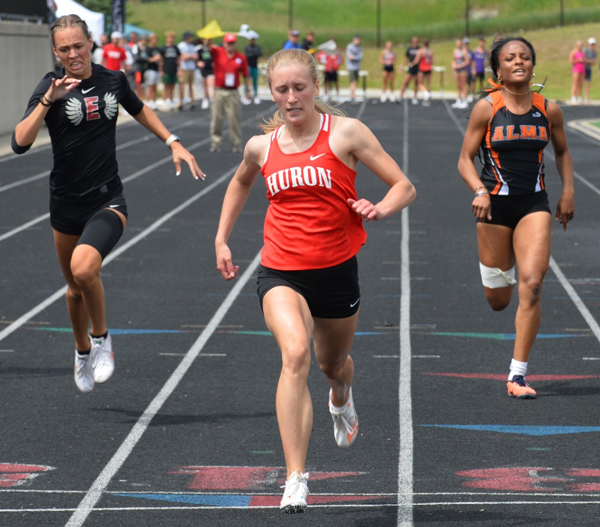
Marquette Girls Prove Peninsula Power
By
John Vrancic
Special for MHSAA.com
June 1, 2013
KINGSFORD — Any questions?
The Marquette Redettes proved they're the Upper Peninsula's best girls track and field team beyond any shadow of a doubt Saturday, claiming their third straight Division 1 title with 145 points.
"We had a (triangular) meet in Escanaba on Tuesday, and it worked out well," said Marquette coach John Peterson. "I think it helped us keep our competitive edge."
Negaunee edged Escanaba 62½-54 for the runner-up trophy.
Freshman distance ace Lindsey Rudden set U.P. meet records in the 800-meter run in 2 minutes. 16.46 seconds, the 1,600 (5:05.5) and 3,200 (11:26.13) and helped the Redettes win the 3,200 relay.
Her effort in the 800 also was a school record.
"Three U.P. records in one day is pretty amazing," Peterson said. "Shayla Huebner running a 59-second quarter is also an excellent performance. We had so many kids do well today. They responded to every challenge in their way. This was just a fun day to see them compete."
Rudden's effort topped a pair of U.P. records from 2001, including a 2:21.3 clocking by Menominee's Mandy Long in the 800 and 11:38.2 by Sault Ste. Marie's Natalie Cahill in the 3,200.
 Also falling by the wayside was the previous 1,600 record (5:19.73) by Iron Mountain's Kelly McClure in 2005.
Also falling by the wayside was the previous 1,600 record (5:19.73) by Iron Mountain's Kelly McClure in 2005.
"I felt great today," Rudden said. "Although I was also real nervous after what happened in the U.P. Cross Country Finals last fall. I have great teammates who will lift you when you're down. We all support and push each other. In the 3,200 relay, all the girls gave it their all. We were just nine seconds off the U.P. record."
Rudden, who went undefeated in all three distance events this spring, also was unbeaten going into the Cross Country Finals.
On that day, she was well ahead of the field with a half mile left in the 3.1-mile race at Munising when she became dehydrated, passed out and needed to be helped off the course.
"I'm realizing I need to become more serious about my running," Rudden said. "I need to be more focused. There's more pressure as it gets later in the season, especially when you're undefeated."
Huebner, who won the 400 at 59.29, added a second place in the 800 (2:21.32) and helped the winning 1,600 and 3,200 relays.
In the field events, sophomore Kirsten Iwanski won shot put at 31 feet, 4 inches, and Hunter Viitala took high jump (5-1).
"Marquette is getting some points in the field events," Peterson said. "It's so much fun to see the kids when they start in the spring and see how far they come. You can't beat the U.P. Finals. This is the best athletic event in the U.P., bar none."
Negaunee's leader was senior Ashley Veale, who won the 100 hurdles (16.57) and 300 (47.31).
Calumet sophomore Chelsea Jacques won the 100 (12.62) and 200 (26.62) and helped the winning 400 relay.
PHOTOS: (Top) Marquette freshman Lindsey Rudden leads the pack during one of her three record-setting races Saturday. (Middle) The Redettes pose with their championship trophy after a third-straight Finals win. (Photos courtesy of Marquette High School.)

Multi-Sprint Champ Racing to Finish Huron Career Ahead of the Rest Again
By
Keith Dunlap
Special for MHSAA.com
May 25, 2023
NEW BOSTON – If there was one thing Elizabeth Anderson took pride in elementary school, it was simply showing that she could outrun everyone in sight.
 In fact, Anderson has an explanation for all the success she had in those playground races.
In fact, Anderson has an explanation for all the success she had in those playground races.
“Dominance when you are in elementary school,” Anderson quipped. “I don’t think I ever had a nickname. I just think everyone knew I was fast.”
Years later, pretty much everyone who follows track & field in the state of Michigan can attest to that.
A senior for New Boston Huron, Anderson has been faster than most other competitors in the state during her three-year high school career (with her freshman season in 2020 canceled due to COVID-19).
Last year, Anderson won titles at the Lower Peninsula Division 2 Finals in the 200-meter (25.07) and 400-meter (56.28) dashes, and was runner-up in the 100-meter dash (12.23).
Often, top sprinters focus on one or two of those three races. But Anderson is certainly a different breed of sprinter because she does all three.
In fact, she holds school records in all three of those events, and if all that weren’t enough, Anderson is a part of all three sprint relay teams.
“It is hard to give her events off,” said New Boston Huron head girls track coach Danielle Lobato.
Despite the different styles the 100, 200 and 400-meter dashes present, Anderson said there usually isn’t much adjusting when she goes from one of those races to another.
 The strategy is simply, “Let’s beat the other girls to the finish line.”
The strategy is simply, “Let’s beat the other girls to the finish line.”
“I don’t really go into each race changing up how I would run,” she said.
While enjoying and succeeding in all three races, Anderson said she actually does have a favorite among them.
“I would say the 400 is probably my favorite,” she said. “Even though it hurts, it’s satisfying to see how much you can get your time down in the 400 compared to any other race.”
Anderson said she started running track in sixth grade, but really got serious about it during the summer after her sophomore season, when she was invited to run for a local club.
Eventually, that led to her competing over the winter in indoor events.
She lived and breathed track so much that last fall, she decided to not run cross country so she could focus on a weightlifting regimen aimed at developing more leg strength.
“Once I started doing summer track, I realized I wanted to be doing this all the time,” she said.
Lobato said oftentimes in practice, Anderson is a de facto coach, given there is no better person she can think of for the younger runners on the team to learn from.
“I can’t always demonstrate these things I’m trying to teach,” she said. “You get to see it in real life (from Anderson), not in a YouTube video.”
After winning the 100, 200 and 400-meter dashes at her Regional meet last week, Anderson has her sights set on achieving the same trifecta of titles at next Saturday’s Finals in Grand Rapids.
Anderson has signed to run track at Michigan State, but has been plenty motivated to keep producing this spring in her final high school season.
“I’m really looking to defend my titles,” she said. “That is what is really motivating me to keep going. I want to keep in shape for the college season. I don’t want to lose any of the progress I have made. Ultimately, I just love running track.”
And since elementary school, Anderson has loved — and succeeded in — outrunning everyone else to the finish line.
“We knew we were getting something special,” Lobato said of when Anderson arrived in high school. “But you never expect this. All that she has accomplished is amazing.”
 Keith Dunlap has served in Detroit-area sports media for more than two decades, including as a sportswriter at the Oakland Press from 2001-16 primarily covering high school sports but also college and professional teams. His bylines also have appeared in USA Today, the Washington Post, the Detroit Free Press, the Houston Chronicle and the Boston Globe. He served as the administrator for the Oakland Activities Association’s website from 2017-2020. Contact him at [email protected] with story ideas for Oakland, Macomb and Wayne counties
Keith Dunlap has served in Detroit-area sports media for more than two decades, including as a sportswriter at the Oakland Press from 2001-16 primarily covering high school sports but also college and professional teams. His bylines also have appeared in USA Today, the Washington Post, the Detroit Free Press, the Houston Chronicle and the Boston Globe. He served as the administrator for the Oakland Activities Association’s website from 2017-2020. Contact him at [email protected] with story ideas for Oakland, Macomb and Wayne counties
PHOTOS (Top) New Boston Huron's Elizabeth Anderson clears the finish line during last season's LPD2 400 race. (Middle) Anderson, middle, outpaces the field to also win the 200. (Click for more from RunMichigan.com.)

